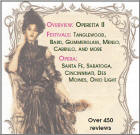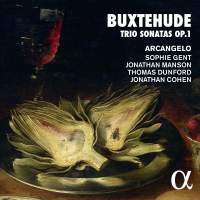Texte paru dans: / Appeared in: |
|
|
Outil de traduction ~ (Très approximatif) |
|
|
Reviewer: Peter
Loewen Before Arcangelo Corelli standardized the forms of the church and chamber sonatas, there were concertata sonatas like these. The seven sonatas of Dietrich Buxtehude’s Opus 1 (1694) treat the violin and bass viol as soloists over a harpsichord continuo. Buxtehude experiments with various forms of strict and free counterpoint, sometimes contrasting dense harmonic progressions with dance-like and lyrical writing, blistering scales, and the wild disorder of chromaticism, all in a single through-composed sonata. The Third Sonata in A minor is particularly noteworthy for its extreme chromaticism, which may remind one of the violin sonatas of Biber and Schmelzer. The previous three recordings of the Opus 1 I have reviewed show a similar high level of achievement. The most obvious difference involves instrumentation. Arcangelo adds some plucked continuo (Thomas Dunford, lute), and the quartet of Manfredo Kraemer adds gravity to the continuo part with violone (Dane Roberts; Harmonia Mundi 901746; J/A 2002). The other excellent recordings are by L’Estravagante (Arts 47731; S/O 2008) and the Purcell Quartet (Chandos 766; J/A 2010). Notes are in English | |
|
Support us financially by purchasing this disc from eiher one of these
suppliers. Un achat via l'un ou l'autre des fournisseurs proposés contribue à défrayer les coûts d'exploitation |
|
|
|
|
|
Cliquez l'un ou l'autre
bouton pour découvrir bien d'autres critiques de CD |
|




